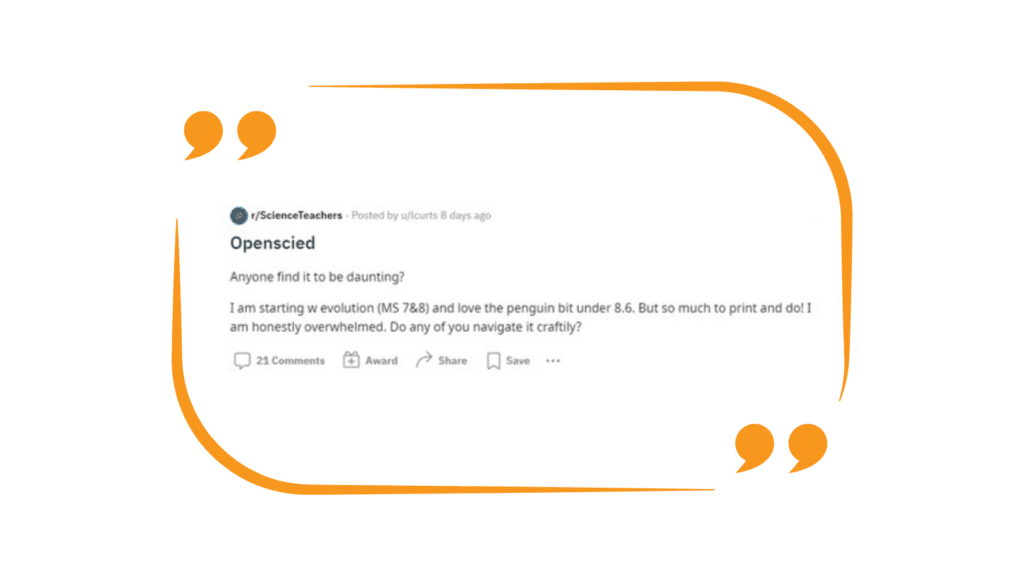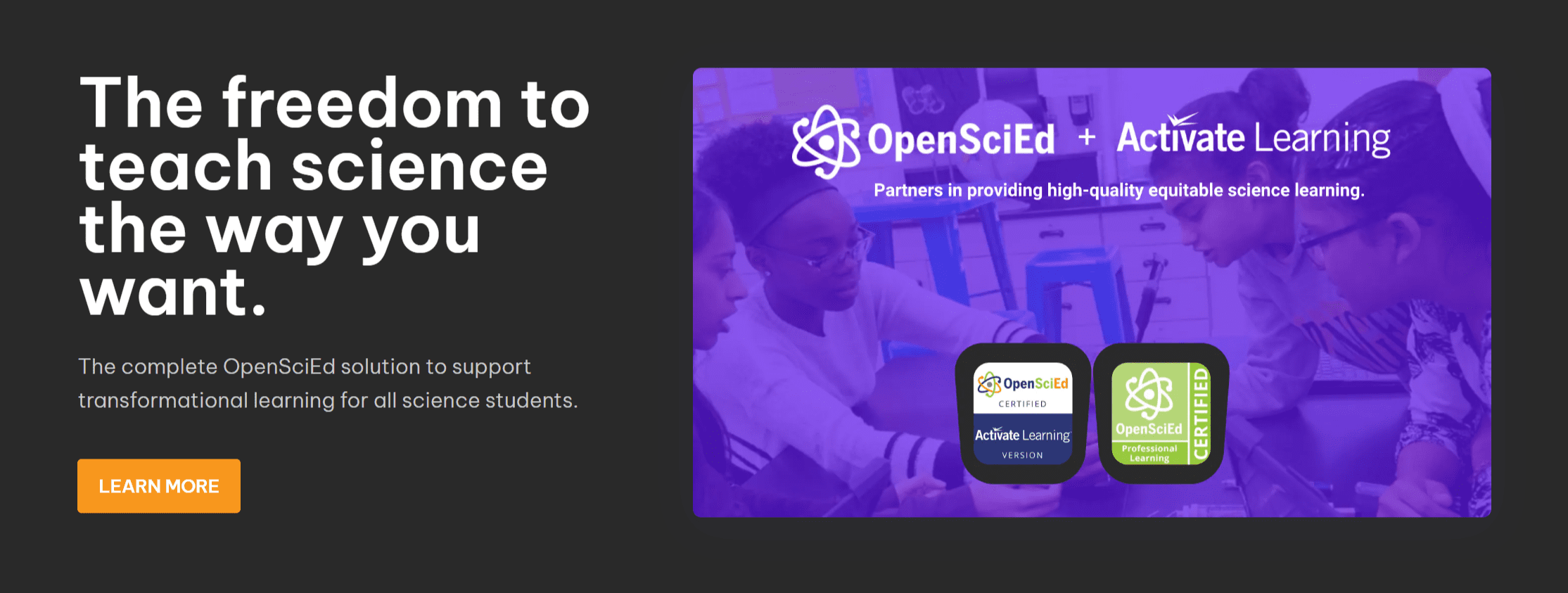Three Challenges to Avoid When Implementing OpenSciEd Curriculum

OpenSciEd middle school science curriculum has rapidly been gathering popularity as a powerful alternative to traditional science education, but that doesn't mean that it doesn't come with its challenges. Making the paradigm shift can be overwhelming for many, so it's important to anticipate some of the obstacles that you'll face when implementing OpenSciEd curriculum.
We spoke to Activate Learning professional learning specialists, Tracy Marmolejo (Professional Learning Manager) and Jen Guitierrez (Customer Success Specialist), who run OpenSciEd implementation workshops and asked about the common patterns and trends that they heard about from the teachers they worked with. This article is a consolidation of those conversations - laying out the three major challenges that you will want to overcome during your implementation.
Let's dive in.
Challenge #1: Going it Alone
Just because the curriculum is open-source doesn't mean that you need to go it alone - even superheroes need support! OpenSciEd has a vast amount of content and it can be very overwhelming to figure out how to cover six curriculum units effectively during the year.
Teachers love OpenSciEd because it creates high-quality instructional resources that meet the highest learning standards (such as Next Generation Science Standards) and can easily be tailored based on the individual needs of students. The freedom and flexibility of using high-quality, open-source materials empowers teachers to create more personalized learning that suits their classroom needs. However, even a seasoned science teacher can find the volume of content overwhelming.
One science teacher became so overwhelmed with their OpenSciEd implementation that they sought help in the Science Teachers Subreddit, causing quite a few more teachers to chime in with similar experiences:



Tracy summarizes the concerns of teachers who say: "How can we get through all 6 units in a year? Where do you expect me to put all this stuff in my classroom?"
To give you a sense of how much content there is, let's just look at the amount of paper that is involved here:
| Teacher Edition | Student Edition | |
| Grade 6 | 1,913 pages | 641 pages |
| Grade 7 | 2,205 pages | 715 pages |
| Grade 8 | 2,122 pages | 786 pages |
| Total | 6,240 pages | 2,152 pages |
If we assume 1 teacher per grade, and 150 students per grade, this translates into 327,540 pages of printed content!
Jen shares that, in their work with districts across the US, teachers have shared that there are definitely benefits to working with Activate Learning because of the support in organizing the vast materials associated with OpenSciEd. This was also echoed by a teacher in the SubReddit discussion:

The key to avoiding this is to hire an experienced curriculum company like Activate Learning, who will take the 8,000+ pages of material and transform it into a digestible, streamlined, cost-effective curriculum for teachers and students, without reducing the high-fidelity content. Having this professional assistance for strategic implementation makes a world of difference when done right.
Challenge #2: Moving Students from "Learning About" to "Figuring Out"
One of the biggest shifts in 3-dimensional teaching and learning is moving away from telling the student what they will learn to having students figure it out, with the teacher serving as facilitator.
"Once the teacher sets up the classroom culture, students don't have a problem shifting to being the driver of their learning. It is about the teacher having trust in the process that is developed by OpenSciEd," says Tracy. The shift needs to come first from the teacher and this needs to be at the front of their mind when implementing the curriculum.
OpenSciEd has a great resource that lays out some of the features of a strong classroom culture that teachers should strive to build:
- Work to ensure that all children are engaged in classroom activities.
- Reinforce the fact that the teacher is not the only one who holds important ideas and that students should feel comfortable lending ideas to discussions.
- Make a safe space for students to bring their life circumstances and context to the classroom.
- Focus on principles and experimentation rather than rote learning.
- And so on…
All of these social and environmental factors are a crucial component of getting OpenSciEd to work, and they should be intentional decisions rather than being left on the back burner for a culture to emerge on its own.
Challenge #3: Building and Maintaining a Strategic Professional Learning Plan
In Tracy's opinion, this is the biggest mistake that gets made with OpenSciEd implementations. "The biggest challenge is when school systems implement a new science program without giving the requisite time for proper teacher training."
Key principles, synthesized by the National Academies of

"Boston Schools teachers at Activate Learning's OpenSciEd professional learning workshop learning Unit 7.1 Chemical Reactions (Photo Credit: Jen Guitierrez)
Science, Engineering and Medicine the research on effective classroom learning and teaching; building pedagogical content knowledge using research-based instructional strategies in the classroom; supporting teacher leadership; integrating professional learning with local and state priorities and systems; and continuously evaluating effectiveness.
Implementing OpenSciEd is not just about the material, it's also about building the teacher's confidence to make the shift to 3-dimensional teaching and learning. This is not just something that needs to happen immediately, but the district should provide regular training for at least the first two years of the implementation to ensure that the system is working as it should. Without this, you'll find yourself in a position where a teacher is not empowered or inspired to get the most out of the curriculum.
This needs to come from the top, as we discussed in a previous post: "If you don't have support from management, high-quality training for your teachers, and empathy for the current workload - you're going to run into issues." It's only through investing in proper professional training for your teachers that you'll be able to navigate the challenges and come out with an OpenSciEd program that works for everyone.
Here at Activate Learning, we are OSE certified for PD. We can help with this sort of training - providing the support and experience that teachers need to define and optimize their strategies and tactics. Activate Learning also has a customer success team to support them every step along the way. By having this crucial support, you significantly improve the chances of success and reduce the feeling of overwhelm that can get in the way of quality instruction.
-----
A big thank you to Tracy Marmolejo and Jen Guitierrez for their contributions to this post and for sharing some of the most common mistakes they see being made by schools and teachers who are moving to the OpenSciEd curriculum. Hopefully, by being aware of these, you can avoid making the same errors and thus greatly improve the overall success of your program. Get more insights and answers to questions on implementation strategies in our monthly OpenSciEd newsletter by subscribing HERE.
As always, if Activate Learning can help in any way, please do get in touch! We'd love to hear from you and see if we can become that professional partner that can make your OpenSciEd journey that much more achievable. We can't wait to see how we can help you!
* * * * *
.




